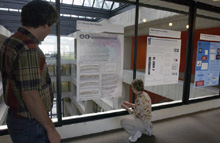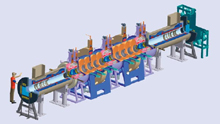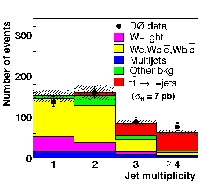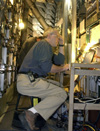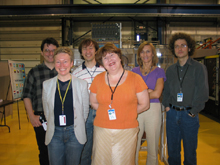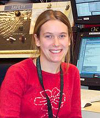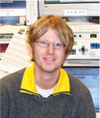 | Thursday, May 26, 2005 |
|
Thursday, May 26 2:30 p.m. Theoretical Physics Seminar - Curia II Speaker: G. Salam, LPTHE, Paris Title: Impact of Higher Orders in the High-Energy Limit of QCD 3:30 p.m. DIRECTOR'S COFFEE BREAK - 2nd Flr X-Over THERE WILL BE NO ACCELERATOR PHYSICS AND TECHNOLOGY SEMINAR TODAY
Friday, May 27 |
|
Extended Forecast |
Secon Level 3 |
|
Thursday, May 26 Santa Fe Black Bean Soup Sloppy Joe $4.75 Tex-Mex Lasagna $3.75 Sauteed Liver & Onions $3.75 Baked Ham & Swiss on a Ciabatta Roll $4.75 California Pizza $2.75 Crispy Fried Chicken Ranch Salad $4.75 The Wilson Hall Cafe now accepts Visa, Master Card, Discover and American Express at Cash Register #1.
Wilson Hall Cafe Menu |
| Fermilab Today is online at: http://www.fnal.gov/today/ Send comments and suggestions to today@fnal.gov Fermilab Today archive Fermilab Today PDF Version Fermilab Result of the Week archive Fermilab Safety Tip of the Week archive Linear Collider News archive Fermilab Today classifieds Subscribe/Unsubscribe to |
|
Posters on Display from Annual DOE Review | ||
| ||
|
From the Science Grid to the ILC, thirty-three Fermilab researchers
prepared posters covering a broad range of topics as part of this week's
Annual DOE Program Review. Due to time limitations during the review,
many of the posters present topics that were only briefly covered in oral
presentations to the review committee.
"The posters represent a nice summary of the various research fields performed at Fermilab," said the Technical Division's Emanuela Barzi, who helped organize the poster session together with Win Baker and Fernanda Garcia. "In an ever faster paced world, spending a couple of hours browsing through these posters might possibly be the most efficient way to get updated on state-of-the-art research."
The posters are on display on the 15th floor of Wilson Hall. They will remain
available for viewing until Tuesday, May 31. A selection of the posters are
also available online.
|
|
May 23 - May 25 - During this 48 hour period Operations established two stores that provided the experiments with approximately 29 hours and 45 minutes of luminosity - Problems with RF and Timing, along with a bad Wet engine flywheel make for long shot setups.
Read the Current Accelerator Update |
|
From the Stanford Report, May 25, 2005 Young physicists featured in NOVA documentary on Einstein's famous equation by Kendall Madden Huge floodlights cut across the cavernous expanse of the Stanford Linear Detector and illuminate the outer wall of the control room. Coils of artificial fog seethe from a machine hidden at the end of a makeshift plank walkway raised several feet off the floor. The mist floats along the planks and rises toward the ceiling, several stories above the heads of the bustling camera crew. The wall of the control room is a massive grid of switches and multi-colored lights that blink like goblin eyes. The entire space—which houses equipment once used in the world's largest physics collaboration—has assumed an eerie, underworld quality. It is Harry Potter meets particle physics. Read more |
|
Beauty Leads to the Top | ||||
| ||||
|
While it has been ten years since its discovery by the CDF and
DZero collaborations, we still know little about the top quark.
One of its most striking properties is the fact that it weighs as much
as a gold atom while presumably being an elementary particle. By itself,
this opens the tantalizing possibility that the top quark might be closely
related to the mechanism by which particles acquire mass and therefore
offer insight into one of mankind's most fundamental questions: "what
is the origin of mass?". This requires detailed measurements of all top
quark properties, a task fully within reach of experimenters at the Tevatron
Run II thanks to the impressive performance of the accelerator and the CDF
and DZero detectors. The DZero experiment has come a bit closer to answering
this question by performing a precise measurement of the production rate of top quark pairs.
Its extremely short lifetime does not allow to detect the top quark directly by interaction with the detector. However, it can be recognized by one of its decay daughters, the bottom quark (b quark), which has a very characteristic property: it can travel several millimeters before decaying to lighter particles. DZero's silicon microstrip tracker is used to reconstruct b-decay vertices, allowing to identify with high efficiency top quark pair events, while rejecting most of background events, which rarely feature b quarks in the final state. So far, the measurement of the top quark pair production cross section is found to be in agreement with the Standard Model expectation. A plain English summary of this measurement can be found here, together with a link to the full article submitted for publication. | ||||
| ||||
| ||||
| ||||
|
Result of the Week Archive | ||||
|
Weekly Time Sheets Due Tomorrow With the upcoming Memorial Day Holiday on Monday, Weekly Time Sheets are due in Payroll by 10:00 a.m on Friday May 27, 2005 Save the date! Witherell Symposium, Reception on Thursday, July 14 Fermilab will hold a symposium, "Fermilab Science: The Witherell Years" in honor of Michael Witherell, who will leave his position as director on June 30. The Symposium will be held in Ramsey Auditorium on the afternoon of July 14, and will be followed by a labwide reception at 4:30 p.m. in the Wilson Hall atrium. Fermilab Today will publish more details as soon as they are available.
2-for-1 Tickets for World Premiere |
